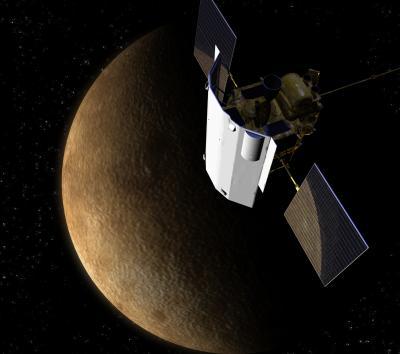University of Colorado researchers will scan Venus during a spacecraft flyby this week using an $8.7 million instrument they designed and built for NASA's MESSENGER Mission, launched in 2004 and speeding toward Mercury.
Built by CU-Boulder's Laboratory for Atmospheric and Space Physics, the instrument will make measurements of the thick clouds and shrouded surface of Venus during the June 5th flyby, said LASP Senior Research Associate William McClintock, a mission co-investigator who led the CU-Boulder instrument development team. An artists rendition of NASA's MESSENGER spacecraft, which will make its first flyby of Mercury in 2008. Credit: NASA/Johns Hopkins University Applied Physics Laboratory/Carnegie Institution of Washington
An artists rendition of NASA's MESSENGER spacecraft, which will make its first flyby of Mercury in 2008. Credit: NASA/Johns Hopkins University Applied Physics Laboratory/Carnegie Institution of Washington
Known as the Mercury Atmospheric and Surface Composition Spectrometer, or MASCS, the instrument will compare the atmosphere of Venus with data from other spacecraft that have visited the planet in the past four decades.
"This is our first opportunity for a close flyby of a solar system object with MESSENGER, and we should be able to tell if the atmosphere of Venus has been changing in recent years, " said McClintock. "As importantly, we are using Venus as a test case to learn more about our instrument performance in preparation for the spacecraft's ultimate destination of Mercury."
Carrying seven instruments, MESSENGER will be the first spacecraft ever to orbit Mercury and the first to return data from the hot, rocky planet in more than 30 years. The circuitous, 4.9 billion mile journey to Mercury, which requires more than seven years and 13 loops around the sun, is using the gravity of Venus during its flyby this week to guide it closer to Mercury's orbit.
MESSENGER will make its first flyby of Mercury in January 2008, zipping by it again at a top speed of 141,000 miles per hour in October 2008 before flying by a third time in September 2009 and finally settling into orbit in March 2011. "This is a mission that requires some patience," said Mark Lankton, LASP's program manager for the MASCS instrument. "We are anticipating a brief symphony of action at Venus, and we have a lot of data to take in a hurry."
Dozens of CU-Boulder undergraduate and graduate students will be involved in data analysis from MESSENGER in the coming years, said Lankton.
MASCS's ultraviolet and visible spectrometer will be looking at the cloud composition of Venus. While the surface of Venus is hot enough to melt lead and its atmosphere is filled with noxious carbon dioxide gases and acid rain, Earth and Venus were virtual twins at birth, scientists believe.
The miniaturized MASCS instrument, which took more than three years to develop, weighs less than seven pounds and was built to last, said McClintock. "Many space instruments have a lifetime of only three to four years," he said. "But we knew we had to make this one robust enough to work for more than a decade under harsh conditions."
The MESSENGER spacecraft is about the size of a small economy car and is equipped with a semi-cylindrical thermal shade to protect it from the sun. More than half of the weight of the 1.2-ton spacecraft consists of propellant and helium. "We like to call it the little spacecraft that could," said McClintock.
"This event at Venus will be a very good tune-up for our first flyby of Mercury next January," said LASP Director Daniel Baker, also a co-investigator on the MESSENGER team. "The first encounter with Mercury will be extremely valuable, as it will essentially double the amount of information we now have about the planet."
A space physicist, Baker is interested in the magnetic field of Mercury and its interaction with the solar wind, including "substorms" associated with Mercury's magnetic field that occur in the planet's vicinity. Understanding Mercury's surface, tenuous atmosphere and magnetic field are the keys to understanding the evolution of the inner solar system, he said.
Mercury was visited only once before by a spacecraft, in 1974 and 1975, when NASA's Mariner 10 spacecraft made three flybys and mapped roughly 45 percent of the planet's rocky surface at the time.
MASCS will probe the mineral composition of Mercury's surface, the distribution of gases in its tenuous atmosphere and the workings of a giant, comet-like sodium gas cloud enveloping the planet, said McClintock. The researchers also hope to determine if Mercury ever had volcanoes on its surface and if the permanently shadowed craters at Mercury's poles contain water-ice.
MESSENGER is equipped with a large sunshield and heat-resistant ceramic fabric because Mercury is about two-thirds of the way nearer to the sun than Earth and is bombarded with 10 times the solar radiation. Sandwiched by the sun and Mercury -- which has daytime temperatures of about 800 degrees Fahrenheit -- the spacecraft will "essentially be on a huge rotisserie," said Baker.